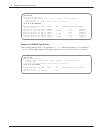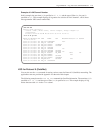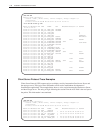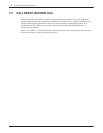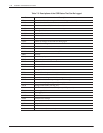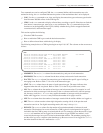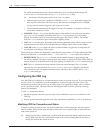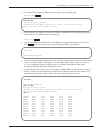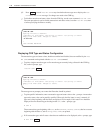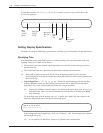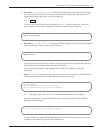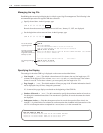
Log
Commands — Log, List Trace, Call Detail Record 7-25
Octel Overture 200/300 Serenade 3.0
PB60014–01
Two
commands are used to configure CDR: the
LOG
command defines which transactions are to be
retained in the log; the
CDR
command indicates the portion of the retained data that is to be displayed.
-
LOG.
Use the
LOG
command to set, clear
, and display the transaction types and status types that the
Octel Overture 200/300 collects in the CDR log file.
-
CDR.
Use the
CDR
command to display collected data, according to specific filters that can limit the
time interval, transaction type, status type, or any combination. The
CDR
command also provides
functions to set the beginning of the log file, identify whether the log file has wrapped around and
overwritten itself, and format the output.
This section explains the following:
-
What the CDR file contains
-
How to enable the CDR log to record the desired transactions
-
How to define selected items within the log for display
The following example shows a CDR log that begins on April 18, 1997. The columns on the screen are as
follows:
@CDR
MM/DD/YY HH:MM:SS XACTIN STAT MS ME PRT DURATN MAILBOX COS CALLER
04/18/97 00:00:24 LPOUTC ERR 009 0:00.1 4450
04/18/97 00:00:25 OFOUTC OK 020 0:00.1 7395
*04/18/97 00:01:06 LOGON BADP 00 00 020 0:00.7 7395
04/18/97 00:01:12 LPOUTC ERR 009 0:00.1 4450
04/18/97 00:06:13 LPOUTC ERR 009 0:00.1 4450
04/18/97 00:06:15 OFOUTC OK 020 0:00.1 7395
*04/18/97 00:06:56 LOGON BADP 00 00 020 0:00.7 7395
04/18/97 00:07:14 CALINT OK 01 033 0:01.7 2070 252
04/18/97 00:07:14 FAXRCV OK 01 007 0:01.7
- MM/DD/YY.
The
MM/DD/YY
column lists the month, day
, and year of each transaction.
-
HH/MM/SS.
The
HH/MM/SS
column lists the hour
, minute, and second of each transaction.
-
XACTIN.
The
XACTIN
column lists transaction type or indicates the specific type of calling or
messaging event. Refer to T
able 7-2 for a list of the transaction types.
- STAT
.
The
STAT
column shows the status of each transaction type. The status indicates what
happened when that call was placed. Refer to T
able 7-3 for the list of possible status values.
-
MS.
The
MS
column shows the number of messages sent in that transaction. For example, in a call
transaction in which no message is left, the entry in the
MS
column would be 00; with one message
left, the entry would be
01
. A
LOGON
entry equals the number of messages sent by the mailbox
holder while logged on. A
FAXRCV
entry indicates the number of fax pages received.
-
ME.
The
ME
column shows the number of messages erased while the mailbox holder was logged on.
- PRT
.
The
PRT
column contains a three-digit designation, starting with 0, of the port that each
transaction came in on. For digital networking entries, this entry is always
000.
- DURA
TN.
The
DURATN
column lists the number of hours/minutes/tenths of minutes for each
transaction. The duration of an event, reflected in a CDR log that is not designated to be logged is
included in the first CDR log entry associated with the call. For example, assume that records of type
CALATT
(call attendant) are not logged, but all transactions of type LOGON are enabled. A call
comes into the message server and is routed to the attendant mailbox. The attendant greeting plays,
and the caller logs on to a mailbox rather than hangs up. Because a record is not logged for
CALATT,
the entire duration of that call is attributed to
LOGON.




